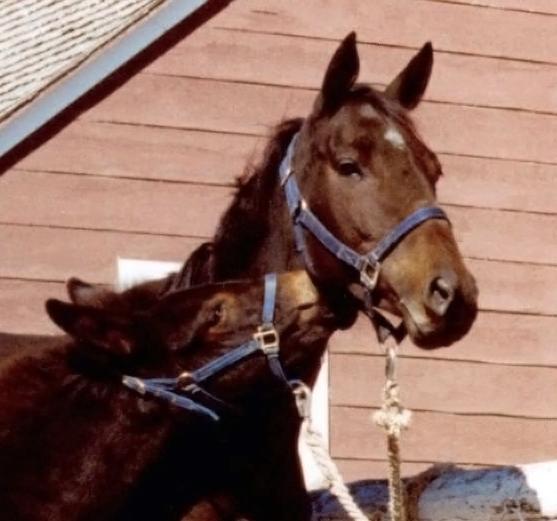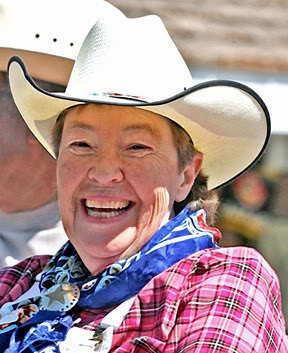|
|
|
|
|
|
 Dear Friends, Dear Friends,
Happy New Year! Each new year is a time for renewed inspiration and hope for the future. The past few years have been difficult at best for the equine industry. With a recessed economy, many horses, mules and donkeys are finding themselves without enough food, and many are without a decent place to live. There are no longer areas for them to subsist in the wild and just turning them loose is not an option. The equine rescues are full and having difficulty feeding and caring for their residents. They rely on donations from generous supporters to help these animals survive in our culture. In addition to our community’s usual help in supporting therapeutic riding centers, rescue organizations and equine food banks should be a donation priority.
Breeders can do their part in helping to alleviate this problem by being responsible and decreasing their expected foal crops, and individual owners should reconsider breeding any animals that are really not fit for breeding. There are other ways for the equine industry to make its money without depending on foal crops. In this economy, it is better to think about quality instead of quantity. This means providing quality care and training for the equines that you do have and educating others so they can provide the same. their part in helping to alleviate this problem by being responsible and decreasing their expected foal crops, and individual owners should reconsider breeding any animals that are really not fit for breeding. There are other ways for the equine industry to make its money without depending on foal crops. In this economy, it is better to think about quality instead of quantity. This means providing quality care and training for the equines that you do have and educating others so they can provide the same.
The LTR website is constantly being updated, so check in often for all the latest news, views, contests, and equine-loving information. And be sure to visit me on Facebook and Twitter. My mission is to help you enjoy your equines as much as I enjoy mine!
Have a wonderful spring and don’t forget—Bishop Mule Days is right around the corner. Make your reservations now for the greatest and biggest mule and donkey celebration on Earth!
Best wishes and Happy Trails,

|
|
Training Tip:
Question: I raised and started Quarter Horses for a long time. I have patience and respect for animals. I know nothing about training mules. I have had this mule (June) for two weeks. The former owner had her for 10 years. She rides good and neck reins, has a good stop and will back. She has several issues I need to work on.
1. Hard to catch: I started yesterday with the plain walking up to her with the halter in the round pen. When I get her caught, I take her straight to the stall where there is half of her feed and tie her ‘til she eats. I will do this twice a day hoping this will help.
2. She won’t give me her head: VERY stiff in the neck. When I ask for her head, she moves her back & her rear in the opposite direction. I have always been successful doing this with horses. Can I hobble her to keep her from moving and try to get her to flex?
3. Ear shy: Have to bridle like a halter. I rub her head toward her ears and then retreat before she moves her head and can, after a while, rub her ears, but I know I couldn’t get a bridle over her head. I am making progress and hope to someday bridle her without unbuckling the bridle.
Do you have any DVDs on these problems? Or any suggestions?
Thanks,
J. B.
Answer: There really are no effective and safe quick fixes for bad behaviors. They are the result of what I call “fragmented” training. Mules and donkeys need to be raised and trained much like children as they are growing up, or even when they are just getting used to new owners. They need to learn over time just what is expected of them in a way that is non-threatening, yet defines limits. No matter how old or how well-trained the animal, they need time doing the simplest of things to get to know you before they will learn to trust and have confidence in you. Just as our children need routine and ongoing learning while they are growing up, so do mules and all other equines. They need boundaries for their behavior clearly outlined to minimize anxious behaviors and inappropriate behavior. The time together during leading training and going forward builds a good, solid relationship with your equine and fosters their confidence and trust in you because you help them to feel good. Read More

|
|
From Our Readers:
Thank you for donating to Abby’s surgery! WE DID IT!!!
Between See’s Candy sales and generous PayPal donations, I raised enough money to get her the pacemaker at Davis. The doctors had to make an adjustment to the device right after the procedure on Tuesday, but she is doing great now and will be coming home on Sunday. I just wanted to send out a quick update and thank you again for your generosity! If it weren’t for you, I'm not sure if Abby would be here. This was a really special Thanksgiving!
Abby and I really appreciate your help!
Thank you,
C. G.

|
|
Bonnie's Bit:
Winter in north Idaho can either be wild and difficult, or long and grey and boring. So far, we’ve had a bit of both.
I got home from Las Vegas and NFR to a foot of snow. Well, that’s not too bad, except it came all at once and the mules didn’t have time to make their paths through the snow. Then, it snowed another foot and they were truly locked in for the duration. And it meant we were, too, in a way. Both their paths and ours were immediately locked in and made of packed snow/ice, and if a foot strayed off that packed path, it sunk two feet. The mules hate that kinda thing, so nobody has been able to move much out there for two months now. And, if I loose a foot off my paths, I am in a world of trouble trying to get back up on my feet and on the path. So, my daily trips to feed can get adventuresome.
The snow is slowly receding right now but spring is still a long ways off for us, so I am not getting too excited. I am spending many hours in the studio, catching up on commissions and such that I have had promised for almost a year in some cases. One being a portrait of Rock and Roll, the Belgian mules Meredith rescued several years ago. You may recall Roll had many problems with a hip and it finally got so bad he had to be put down. He was such a kind and brave mule and Meredith had done wonders with him in the short time she had him.
Now I am waiting on some decisions from the ladies with the children’s book with the bears in it. They hafta decide—square or horizontal. Once that is finalized, my life is pretty well mapped out for several months.
HOWEVER, I will be attending the Small Farmers Journal spring auction in Madras, Oregon April 17-21 with all my wares, and a NEW mule t-shirt. Then it will be Bishop time the last of May and me’n Meredith will get to see everyone there.
Iris continues to be a blessing and I am enjoying her company so much. Can’t ride because of the ice, but I can give her carrots and pets and hay every day and she is happy with that. We are building a relationship.
Ok, sit tight and spring will get here. Like my Leroy mule always told me, “Keep Your Traces Tight.”
Bonnie

|
|
Greetings from the ADMS:
It never ceases to amaze one how time really does fly. Kids turn into teenagers, foals are suddenly grown up, and those young horses and mules standing out in the pasture aren’t young anymore. What happened to those spindly colts?
Vaccinations, worming and hoof care are pretty constant throughout an animal’s lifetime, but nutritional needs can certainly change. A foal has a different dietary requirement than a brood jennet or a twenty-something old darling who is getting long (and sharp) in the tooth. Observe your animals at feeding time, which is also a good time to have some quiet grooming and bonding time. Are they in good flesh, a little ribby, or starting to pad up with fat? How is their haircoat? Thick, slick, or brittle and patchy? Even a winter coat should be healthy and feel nice to the touch.
While there are all kinds of supplements on the market, basics are always better. Donkeys evolved from desert creatures, and we have changed much of their natural way of life by domesticating them. We tend to overfeed many of our pets in the USA as well. Moderation in any feeding program—which includes supplements—is the way to go.
Speaking of standing beside that baby who isn’t so small anymore —does his or her halter still fit? If you have more than one animal, you should have a variety of halters. If you breed, you’ll need those foal halters again and again, and will have many more smaller-to-larger pieces of headgear on hand at all times. Ideally, you should have one halter per animal and at least one spare. The same goes for lead ropes. These winter months when it’s gloomy and we have the blahs is a good time to go out to the tack room with a hot cup of coffee or cocoa and look over tack. If anything is too worn, frayed, rusted or brittle - clean it, repair it or chuck it out. Damaged bridles and halters can lead to disasters—breaking or causing injury.
As your animal matures, it’s time to check the saddle fit as well. If you have a mule, they may still be growing as late as age seven or eight. Does the saddle fit properly since the last time you had it on them? Check the gullet, making sure it doesn’t rub or sit too far down over the withers and spine. In harness, does the collar still fit, or does the padding need adjusting? How about you yourself? Are your stirrups still the same length? Do you need to get a mounting block for ease in getting up into the saddle? A mounting block might be easier for both the more mature you and your more mature animal. Hanging onto the saddle and heaving into the seat can put a lot of stress on an older back—well, two of them! Make things safe and more comfortable for yourself and your aging animal.
Spring will be here before you know it, so be prepared for foaling season by updating your foaling kit as well. And in keeping with being a responsible equine owner, make sure your contact numbers for a close friend and the vet are posted in the barn or stable, as well as near your house phone. Most people now have cell phones, but not everyone puts numbers in them in a way they are easy to access during an emergency. Hopefully emergencies can be avoided, but it’s far easier to just have a list of instructions and numbers handy for the “just in case” situation.
Spend some time with your longears and always tell them you love them! Until next time,
Leah Patton, office manager, ADMS
The Am. Donkey & Mule Soc. PO Box 1210, Lewisville TX 75067 (972) 219-0781. Newsletter: the BRAYER magazine, 100+ pgs 6X/yr, $27 US, $37 Canada, $50 overseas. We now accept Paypal, Visa/MC (+$1 courtesy fee appreciated). Reg info, forms, fees on our website at www.lovelongears.com.
|
|
|
|
|
|
|
|